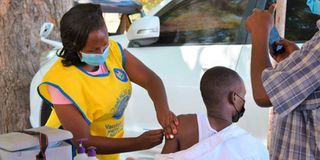Hope as Covid-19 infections fall in September

A health worker administers a Covid-19 jab to a man at the Mama Ngina Waterfront during the Mombasa Foodies Festival yesterday. Over 300 people got vaccinated during the event.
The number of Covid-19 cases has significantly fallen this month, with various hospitals across the country reporting some relief in their coronavirus-dedicated wards.
Data from the Health ministry reveals 17,196 new cases and 522 deaths over the past four weeks.
This will likely raise expectations that restrictions set by the government, such as the night curfew, may be eased since the numbers are much lower compared to August when new infections hit a high of 32,650 and there were 795 deaths.
Hospitals such as the Kenyatta University Teaching Research and Referral Hospital (KUTTRH), which was so overwhelmed early last month that the management sent a memo suspending staff leave, have breathed a sigh of relief.
The hospital’s CEO Victor Njom told the Nation that the number of patients in ICU and in isolation had reduced significantly.
The Nairobi West Hospital management also said they had recorded a significant reduction in the number of Covid-19 patients.
There were only six patients at the hospital, with two in the ICU and the rest in the wards.
This is a tremendous difference from the once full 80-bed Covid-19-dedicated unit at the city hospital. The high number of new infections in August had led researchers and experts to anticipate the onset of a more severe fourth wave, as was the case in March when there were 28,085 new cases and 290 deaths and in April 25,260 cases and 571 deaths.
The expectation was that the fourth wave would peak this month.
A wave is the fluctuating movement of aggregate numbers of something, which can move up to a peak then move down to a low number, usually in a repetitive trend akin to the way waves rise and fall in an ocean.
In the context of an epidemic, a wave refers to an increase in the number of infections to a peak level, followed by a decrease in the numbers to a low point (that is the index or initial wave).
The numbers can rise again and head towards a new peak that defines a new wave, which after the numbers fall marks the end of that wave, then the pattern may repeat itself albeit with different levels of intensity or peaks.
In Kenya, the numbers rose to a peak in June and July last year, then dropped markedly to a very low level, only to rise again to a new higher peak in October and November, before going to a new low level in January and early February.
The numbers started rising again at the end of March and April, ushering in the third wave.
August recorded the highest numbers of Covid-19 cases in Kenya this year.





